Venus-Express
Europe's mission to Venus
News
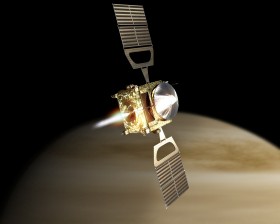 Venus Express is in orbit around Venus
Venus Express is in orbit around Venus
On April 11, 10:10 CET, the ESA Venus Express spacecraft was successfully inserted in the polar orbit around Venus. The 53 minutes burn of the main engine placed the spacecraft in the Capture Orbit around Venus with parameters close to the predicted ones: altitude in pericentre ~400 km, altitude in apocentre ~330,000 km, and revolution period of 9 days.
After the burn was completed the spacecraft automatically returned to the Earth pointing orientation and restored telecommunications with the Cebreros ground station. During the first day in orbit the satellite will restore all functionalities that were shut down for the orbit insertion maneuver. The spacecraft will also be flipped to continue telecommunications with the big dish antenna.
If these operations are successful the first VMC images can be expected in the afternoon of April, 13. In the next two weeks several additional burns will be used to lower the apocentre and form the nominal science orbit with apocentre distance of ~66,000 km.
The Launch
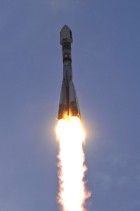 VENUS EXPRESS launch successful
VENUS EXPRESS launch successful
At Nov 9, 2005 03:33 UTC (04:33 CET), the Soyuz-Fregat rocket carrying the Venus Express spacecraft succesfully launched from the Baikonur Cosmodrome, Kazakhstan.
Following the second firing of the Fregat stage, the spacecraft was successfully placed into an escape trajectory.
Details at  ESA.
ESA.
![[Top]](/images/icons/top.gif)
Science objectives
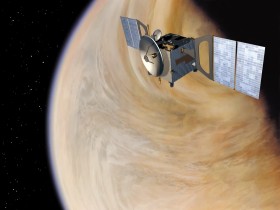
Venus Express aims at a global investigation of the atmosphere, the plasma environment and some surface properties from orbit. The fundamental mysteries of Venus are related to the global atmospheric circulation, the atmospheric chemical composition and its variations, the surface-atmosphere physical and chemical interactions including volcanism, the physics and chemistry of the cloud layer, the thermal balance and role of trace gases in the greenhouse effect, the origin and evolution of the atmosphere, and the plasma environment and its interaction with solar wind. Besides, the key issues of history of Venusian volcanism, global tectonic structure of Venus, and important characteristics of the planets surface are still unresolved.
In spring of 2001 the European Space Agency (ESA) called for ideas to re-use the Mars Express bus. The proposal to use at Venus the slightly modified spacecraft equipped with available payload won the competition with eight other proposals submitted to ESA. The Mars Express and Rosetta heritage, as well as the same industrial and scientific teams, allowed ESA to get the spacecraft ready for launch in less than 4 years that made Venus Express the fastest planetary mission ever built.
The Venus Express mission will give an excellent and appropriate opportunity to make a breakthrough in exploration of the planet. The instruments developed for the Mars Express and Rosetta missions complemented by two small units specifically built for Venus Express are very well suited for this task. The new generation of instrumentation will peer through the thick curtain of sulfuric acid clouds in transparency "windows" to unveil the mysteries of the planetís hot and corrosive atmosphere, to study the mechanisms that maintain hurricane winds and giant vortices, to find the coupling between the planetís extreme climate and active volcanism. In comparison to earlier missions to the planet Venus Express will take advantage of state-of-the-art remote sensing and in situ observation techniques and capable and versatile spacecraft. By the time it arrives to the planet, Venus Express will be the first dedicated orbiter mission to explore the atmosphere of Earthís neighbouring world in over 20 years.
![[Top]](/images/icons/top.gif)
The Spacecraft
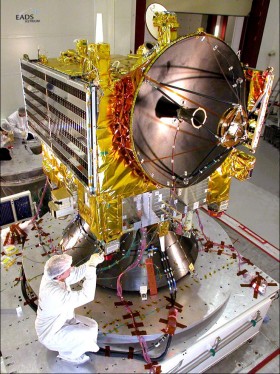 The Venus Express mission re-uses the Mars Express spacecraft with some modifications mainly driven by four times higher solar flux at Venus and the need to accommodate non-MEX instruments. This approach allowed ESA to minimize the costs and development risk and eventually guaranteed readiness for the launch in November 2005.
The Venus Express mission re-uses the Mars Express spacecraft with some modifications mainly driven by four times higher solar flux at Venus and the need to accommodate non-MEX instruments. This approach allowed ESA to minimize the costs and development risk and eventually guaranteed readiness for the launch in November 2005.
Venus Express is a 3-axis stabilized spacecraft. It employs two body-mounted high-gain and one low-gain antennae for telecommunications with the ground stations. The propulsion system uses a single main engine for orbit capture and eight small thrusters for attitude control and orbit maintenance maneuvers. The spacecraft attitude measurements and control are performed using star trackers and gyros. Reaction wheels are used for almost all attitude maneuvers, providing flexibility and accuracy.
The Venus Express electrical system is designed to satisfy the design driving requirements of an interplanetary spacecraft mission such as high autonomy, due to the absence of real time control of the spacecraft from Earth, and the ability to cope with a highly variable environment, in particular, a wide variation in the intensity of sunlight on the solar panels and broad temperature range of solar cells. Electrical power is generated by two symmetrical Gallium Arsenide solar arrays with a total area of 5.7 square metres. The solar arrays will generate about 1400 W in Venus orbit. During eclipse or when spacecraft power demand exceeds solar array capacity, power is supplied by three 24 Ah Lithium-Ion batteries that combine low mass with high-energy efficiency.
The communications system includes a transponder capable of transmitting and receiving in S-Band as well as X-Band and four different antennas: two low-gain S-band antennae, one dual band high-gain 1.3 m antenna, and one high-gain X-band antenna with 0.3m diameter dish. Maximum downlink data rate at Venus is 228 kbps.
The Data Management System is in charge of telecommand distribution to the whole spacecraft as well as telemetry data collection from the spacecraft systems and payload. The onboard Solid State Mass Memory is used for data storage and has a capacity of 12 Gbits.
The Venus Express spacecraft has bi-propellant propulsion system. The main engine generates a thrust of 415 N, and is used for the Venus capture and apocenter lowering. Eight thrusters each capable of producing thrusts of 10 N are located in the lower corners of the spacecraft. They will be used for attitude control and orbit maintenance. Total propellant load is 570 kg that is higher than on Mars Express because of higher ?V requirements for the capture burn.
![[Top]](/images/icons/top.gif)
Scientific Payload
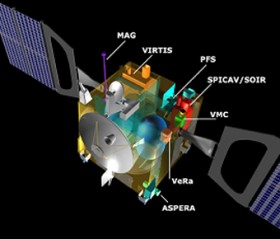 The Venus Express payload consists of seven instruments. Five of them are re-used from the Mars Express and Rosetta projects with small modifications.
The Venus Express payload consists of seven instruments. Five of them are re-used from the Mars Express and Rosetta projects with small modifications.
 ASPERA - the analyzer of space plasma and energetic neutral atoms - will characterize the plasma environment around Venus and study escape processes.
ASPERA - the analyzer of space plasma and energetic neutral atoms - will characterize the plasma environment around Venus and study escape processes.
The Planetary Fourier Spectrometer (PFS) - a high-resolution infrared spectrometer- will study the structure and composition of the Venus middle.
SPICAV/SOIR - a versatile ultraviolet and infrared spectrometer will study the structure and composition of the upper atmosphere of Venus in solar/stellar occultation and nadir observations.
VeRa - a radio science experiment - will use the radio system of the spacecraft to sound the structure of the middle and lower atmosphere and ionosphere in Earth occultation. The experiment will also carry out the bi-static radar sounding of the selected targets on the surface and sounding of the solar corona.
VIRTIS - a sensitive visible and near infrared spectro-imager and high resolution spectrometer - will investigate the structure, composition, and dynamics of the middle and lower atmosphere.
These experiments are complemented by two small units specifically developed for the Venus Express mission. The  Venus Monitoring Camera (VMC) will study the cloud morphology, atmospheric dynamics, and water distribution in the middle and lower atmosphere. It will also provide thermal imaging of the surface and search for volcanic activity.
The magnetometer will measure the magnetic field "frozen" in the circumplanetary plasma supporting the ASPERA observations.
Venus Monitoring Camera (VMC) will study the cloud morphology, atmospheric dynamics, and water distribution in the middle and lower atmosphere. It will also provide thermal imaging of the surface and search for volcanic activity.
The magnetometer will measure the magnetic field "frozen" in the circumplanetary plasma supporting the ASPERA observations.
![[Top]](/images/icons/top.gif)
Related links
